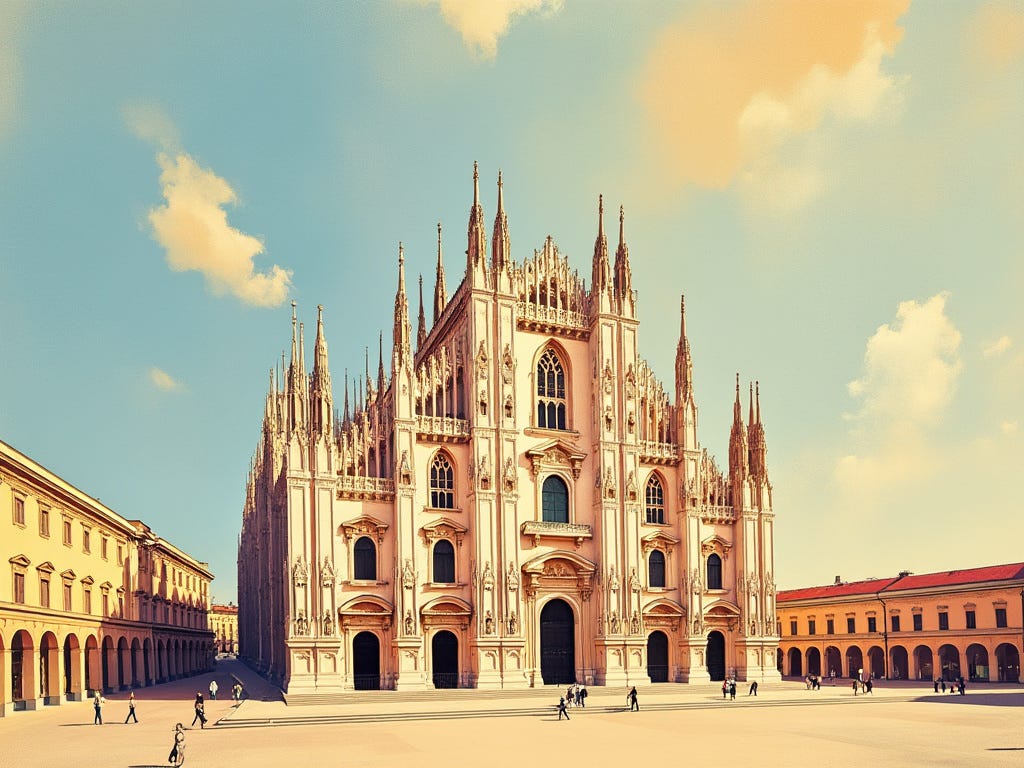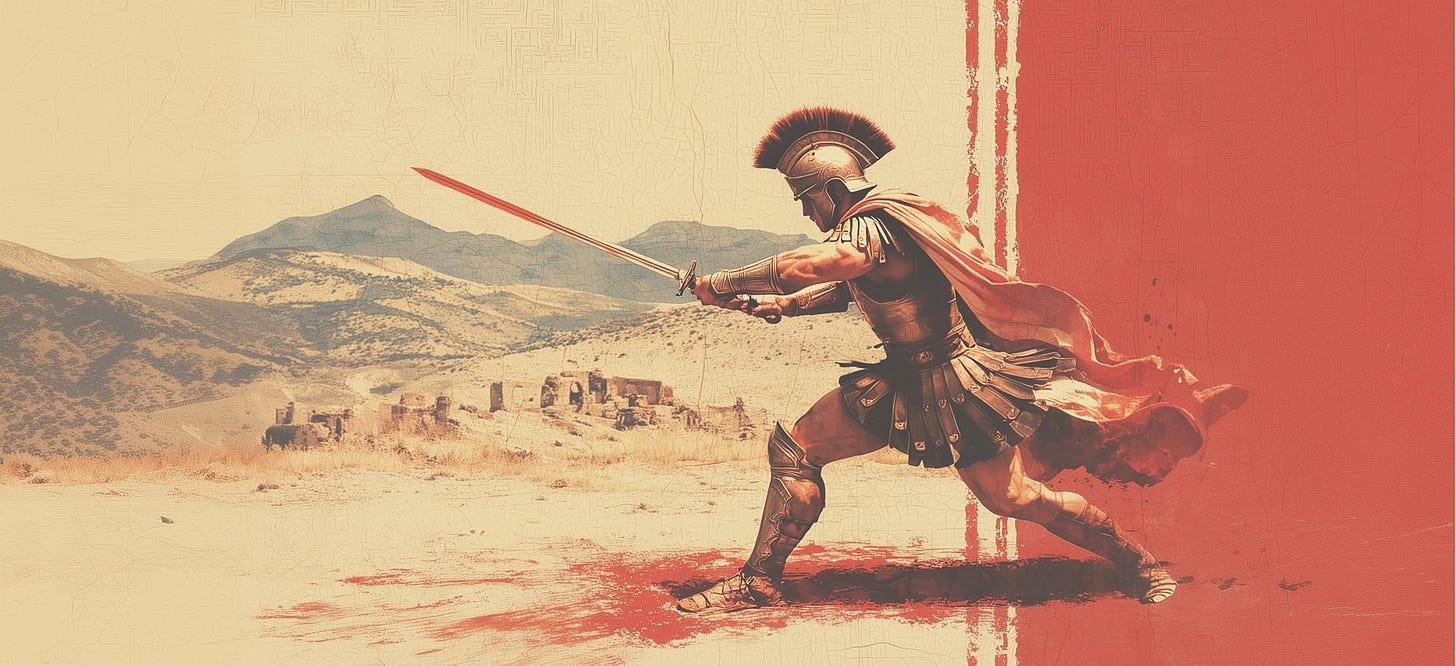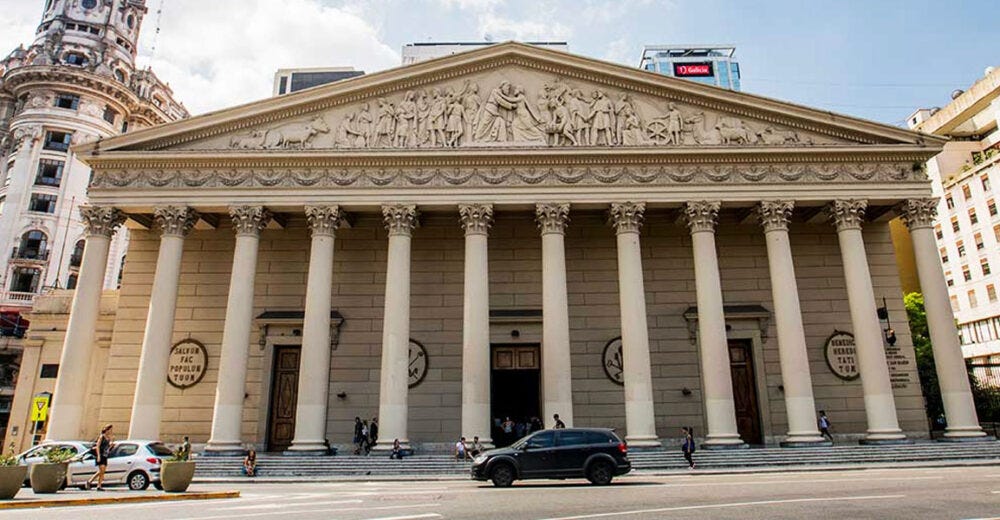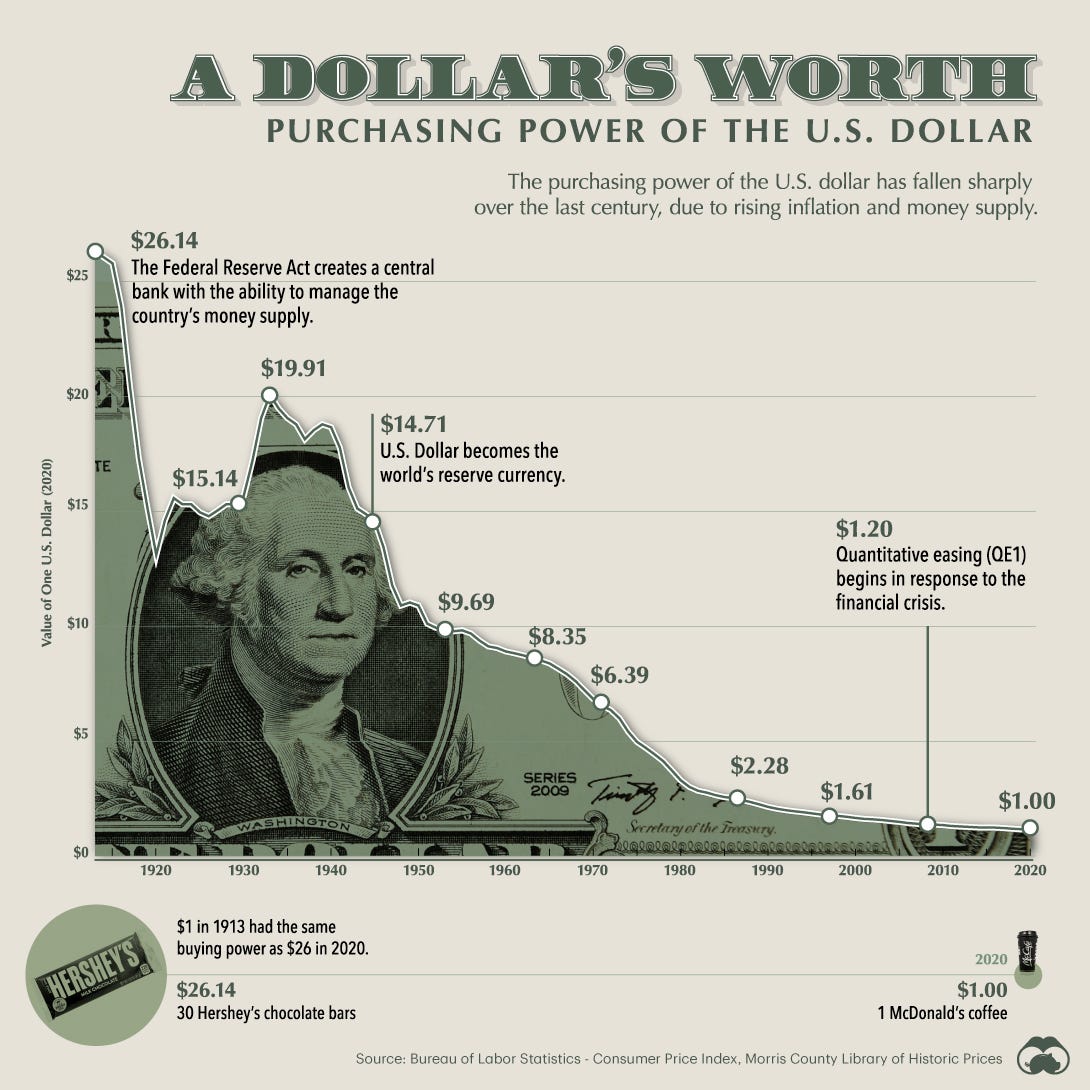🕍 Cathedral Consciousness: Three Uncomfortable Truths.
the lost arts of legacy, transcendence, and economic bedrock.
📖 Reading Time: ~6 minutes.
🏴 Vibecheck: I’m in a deep reckoning with Western Culture. For years I have criticized Modern Western Culture, but something has shifted. I am reexamining and reclaiming my cultural heritage. I’ll write more about this next week.
Today, I’m introducing a new daily publication. I’ve got the first month of content outlined and it will be FIERCE – the first post goes out Monday. To a bright future, EB. 🥋
[NEW] Blood & Ink
I’m excited to introduce a new publication: Blood & Ink.
Blood & Ink is a daily digest – I’ll drop a short and sharp piece every morning.
It is centered around the Warrior archetype, culture & civilization, human potential, timeless wisdom, and current event commentary. An outlet for experimental, off-the-cuff, powerful posts, and to ritualize my writing practice.
Drawing inspiration from this legendary quote from Miyamoto Musashi:
“It is said the warrior's is the twofold Way of pen and sword, and he should have a taste for both Ways.”
Although Substack gave me the option, in good faith I can’t add everyone automatically. You must subscribe yourself if you want to receive these.
Dive into living the Way of the Warrior:
I will continue to post here on Serious Play—weekly—with longer essays like the one below. I hope you enjoy both, and I hope you’ll join me over there.
The Duomo di Milano, a central cathedral in Milan, began construction in 1386 and was completed in 1965…
579 years.
Towering as the largest church in the Italian Republic—3rd largest in the world—it’s a living beacon of Gothic architecture. Leonardo da Vinci himself contributed to its construction over its long lifetime.
While not all cathedrals rise over 6 centuries, the average cathedral took ~300 years. A mind-boggling amount of time.
You might have come across the term ‘cathedral consciousness’ in select corners of the internet.
The idea is a semi-reactionary movement against the short-term, shiny-object schizophrenic attention of the modern age; cathedral consciousness is a psycho-spiritual invitation to vastly expand your time horizon.
I stumbled into cathedral consciousness several years ago and ate it up.
It was a ‘shiny dime’ idea, as Write of Passage godfather David Perrell might say: a simple, compelling idea that conveys a ton of juicy inspiration.
It’s a calling card for those who want to contribute to greater things. It’s found root in the semi-spiritual, chronically online communities hungry for deeper meaning and contribution.
Alas, something unspoken always whispered to me about this term, beckoning to some part of the picture I was not seeing clearly. Over the past few months, a few critical components of cathedral consciousness have emerged more clearly.
This is for those who love the idea of contributing to truly great works, and presents 3 uncomfortable truths about what is required to make them happen.
Enduring Testaments of Legacy.
In grappling with how these projects came into existence and sustained themselves long enough to reach completion, one important component—perhaps the central piece to all of this—rose from the shadows and revealed itself to me:
These projects are testaments of legacy.
They were created and funded by the aristocratic elite. While the soft spiritual part of you clings tightly to the dream that these were purely altruistic endeavours — they were not.
These cathedrals were made as living legacies for the noble families that created them. They were born of the powerful and created for the powerful. Many cathedrals or buildings like this bear the name of the individual or family who created them.
I spent two years living in Buenos Aires, Argentina, home to extremely grand architecture. The vast majority of them were funded by emigrated aristocrats who wanted to establish their legacies and etch their family names in the echoes of eternity.
This is a critical component that the spiritual communities and online aficionados miss.
These were fiercely egoic undertakings, testaments of personal greatness, and channelled expressions of power, fame, and wealth.
The entire metaphysical orientation of the spiritual/self-development communities is a rejection of power, selfishness, grandiosity, hierarchy, ego, tradition, and the rest. It is no coincidence then, that none of these groups have built anything close to these great works.
While you are welcome to your idealistic fantasies that some other way of doing this is possible, that a DAO (decentralized autonomous organization) running an obscure shitcoin fork of Ethereum is going to fund and orchestrate the construction of anything of significance – those who live in reality will see that the only lasting monuments of greatness like this were created by owners building a testament of their legacy, and we have all benefitted from it.
Pursuit of Transcendant Ideals
Of course, the nobility and elites of their times were rarely the ones building the monuments themselves.
300 years is several generations. To sufficiently rally thousands of humans over vast expanses of time, everyone must be rallied behind a greater purpose, a higher vision.
In ancient times, these were offerings to Divinity.
It is no coincidence that most of these great creations are churches, chapels, public squares, fountains depicting religious iconography, or cathedrals.
While they were a testament to legacy of the elites, they were also a pursuit of transcendent ideals. Ideals of beauty, greatness, passion, devotion, worship, strength, and truth.
In his masterwork—On the Genealogy of Morality—Frederich Nietzsche expounds the idea of Master and Slave morality.
Master morality was defined by the rulers, and resembled the virtues that they saw in themselves: power, beauty, vitality, intelligence, and greatness. What was good is what was great.
Born as a reactionary movement against this from the common people, new religions and moral codes arose that espoused the virtue of… precisely the opposite: Slave Morality.
Suddenly virtue was weakness, quietude, ugliness, softness, poverty. You see this reflected in most major religions, and it is this sense of morality that dominates the world today.
It is from this seed that nothing beautiful, substantial, worthy of enduring legacy is born. The very worldview, the living philosophy that created these great works is no longer dominant.
No longer do we pursue the expressions of greatness, vitality, or heroism, lest we offend someone, create a moment of inequality, or hurt someones feelings.
As such, humanity slowly peters out to the lowest, meekest, softest, ugliest common denominator – and great expressions of beauty are lost.
To reclaim cathedral consciousness, we must similarly reclaim Master Morality. We must once again prize and pursue beauty, greatness, heroism, inequality, aristocracy, and nobility.
Unfortunately, this moral code is firmly in our spiritual shadow.
Until the left, the new-age spiritualists, and the common man reclaim greatness, inequality, power, purpose, and vitality as guiding virtues – these works will remain forever out of reach. A bitter pill to swallow.
An Unshakeable, Stable Foundation
Finally, the least exciting yet most overlooked missing piece of cathedral consciousness: sound money.
All great works like this were born in the time of the gold standard.
The 5000-year golden days of money. Gold was the established money all over the world. The hardest to dilute and the best at retaining its value over vast expanses of time.
It is difficult for most to understand how profoundly and how subtlely unsound money corrodes your psychology. When you know that your $1 today will be worth $1 100 years from now, it shifts your time preference – your willingness to discount the present in pursuit of the future.
You save, plan, and pursue longer-term projects. Gold retained its value for over 5000 years. In just 50 years, the US Dollar has lost 97% of its purchasing power.
It’s a critical reframe: housing hasn’t increased in value, your dollar has decreased in its purchasing power.
When you know that your money is going to be worth ~10% less next year than this year, it incentivizes you to spend it, now.
This drives short-term trivial consumption, and the idea of investing in something over centuries becomes a laughable pipe dream.
Modern inflationary money leads us to this short-term, opportunistic cash-grabbing, and prevents us from creating masterpieces that rival the structures erected on a sound money standard.
Reclaiming the Consciousness that Built Cathedrals
Modern culture has lost 3 critical components of cathedral consciousness:
Nobility, Legacy, and Aristocratic Excellence.
Pursuit of Transcendent Ideals and Master Morality.
Stable Economic Bedrocks via Sound Money.
As much as you might see the hopeful idealists on Twitter discussing cathedral consciousness — until these fundamental pillars are restored, no modern cathedrals will rise.
Fortunately, there are steps you can take in your own life now to correct this.
Reclaim Master Morality: Begin to see and act through the lens that greatness, heroism, individuality, power, and excellence are virtues.
Pursue Transcendent Ideals: Ground yourself in enduring philosophical and religious orientations and make yourself useful.
Promote a Sound Money Standard: Of which Bitcoin is the shining beacon.
There is work to be done. Correcting the centuries of psychological drift and sloppy thinking we have endured thus far will not be easy, but hope is not lost.
All of these are possible and within our grasp, should we only desire to pursue them and reach out toward them.
Godspeed,
EB.














Fascinating piece and perspectives, thank you for sharing 🙏🏼
Couple points of pushback:
1. I would not say the main reason the great cathedrals arose was purely because of rich guys wanting to extend their legacy / family name. The sheer majestic sacredness & breathtaking vastness evoked by these architectural miracles reveals Divine inspiration. The handprint of God is on those structures. Whatever other human currents or motivations may have factored in, I would see those factors as being downstream of the Holy Spirit mysteriously working through mankind to make His/Her Presence known in the world — not to mention a great ancient tradition capable of coordinating such faith, effort, vision, and resources over hundreds of years. Plenty of rich guys nowadays try to build epic stuff with their name on it but they don’t come close to the great European cathedrals — because their efforts are self-serving
2. I’d be curious what would happen if you steelmanned what Nietzsche calls ‘slave morality.’ You seem to strawman / caricature it here — I don’t think “ugliness” is considered a virtue by anyone. Thomas Merton (one of Remi’s favorite authors) is a good one to read in this respect. Classic Christian virtues such as humility, simplicity, meekness, chastity, charity, love, asceticism, mercy, & contriteness of heart offer us a great deal of wisdom & beauty to reflect upon. That’s not to say they’re perfect for everyone or that the ‘master’ virtues you highlight cannot also be beautiful. Personally I believe there are interesting ways to synthesize ‘master and slave morality,’ ‘left and right hand path,’ as well as Christianity and New-Age-ism (which often focuses more on individuality, empowerment, etc) — probably endless ways these can be combined, permutated, rebalanced, remixed… no two individuals will ever have precisely the same morality or spirituality
Food for thought — peace and love 🙏🏼❤️🔥